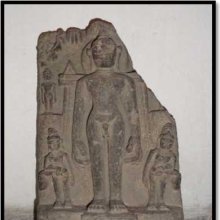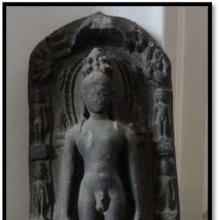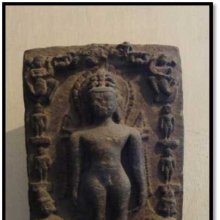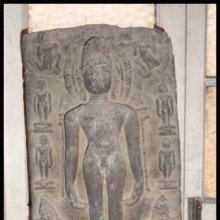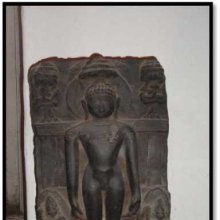Kayotsarga, Kāyotsarga, Kaya-utsarga: 15 definitions
Introduction:
Kayotsarga means something in Hinduism, Sanskrit, Jainism, Prakrit, the history of ancient India. If you want to know the exact meaning, history, etymology or English translation of this term then check out the descriptions on this page. Add your comment or reference to a book if you want to contribute to this summary article.
Images (photo gallery)
In Hinduism
Shilpashastra (iconography)
Source: Shodhganga: The significance of the mūla-beras (śilpa)Kayotsarga (कयोत्सर्ग) or Kayotsargasthānaka refers to the “erect posture”, and represents one of the two types of Sthānaka (standing poses), according to Ganapati Sthapati in his text Ciṟpa Cennūl, as defined according to texts dealing with śilpa (arts and crafs), known as śilpaśāstras.—In kayotsarga posture, the feet are placed together with the body erect and the arms hanging close to the body. The Gomateśvar image in the Jain tradition is a good example for this stance. The Hindu deities are not often found in this stance.
The kayotsarga posture (the feet are placed together, with the body held erect, the gaze direct, the arms hanging close to the body, fingers placed gracefully, and palms held close to the thigh) that is seen in iconography is not found in Bharatanatyam with a separate term but the same action is sometimes depicted while portraying the Gomateśvara icon.

Shilpashastra (शिल्पशास्त्र, śilpaśāstra) represents the ancient Indian science (shastra) of creative arts (shilpa) such as sculpture, iconography and painting. Closely related to Vastushastra (architecture), they often share the same literature.
In Jainism
General definition (in Jainism)
Source: Wisdom Library: JainismKāyotsarga (कायोत्सर्ग) or Kāyotsargapratimā represents the sixth of eleven pratimā (stages) laid down for Jain laymen. Kāyotsarga-pratimā refers to “abstaining from food after sunset” according to J. L. Jaini in his “outlines of Jainism” (pp. 67-70). It is also known as Rātribhuktatyāga-pratimā.
These pratimās (e.g., kāyotsarga) form a series of duties and performances, the standard and duration of which rises periodically and which finally culminates in an attitude resembling monkhood. Thus the pratimās rise by degrees and every stage includes all the virtues practised in those preceeding it. The conception of eleven pratimās appears to be the best way of exhibiting the rules of conduct prescribved for the Jaina laymen.
Source: archive.org: The Jaina IconographyKāyotsarga (कायोत्सर्ग) or Kāyotsargāsana refers to one of the various āsanas (postures) commonly depcited in Jain iconography.—It is well-known that the Indian Yogīs practise the various Āsanas to gain some control of the body, proceeding as they do, towards the Rāja-yoga or higher mental culture.—Cf. Jinamudrā.—The position, so called, when the ascetic stands in Kāyotsarga keeping the feet at four fingers breadth between the toes and lesser width between the heels. Kāyotsarga literally means “letting loose the body”.
Source: archive.org: TrisastisalakapurusacaritraKāyotsarga (कायोत्सर्ग) or Kāyotsargāsana refers to “indifference to the body by one standing or sitting, with the arms hanging down”, according to chapter 1.1 [ādīśvara-caritra] of Hemacandra’s 11th century Triṣaṣṭiśalākāpuruṣacaritra: an ancient Sanskrit epic poem narrating the history and legends of sixty-three illustrious persons in Jainism. Accordingly, “[...] [Dhana] saw Munis there, some engaged in meditation, some absorbed in silence, some engaged in kāyotsarga; some were reading aloud the scriptures, some were teaching, some sweeping the ground, some paying homage to their gurus, some discoursing on dharma, some expounding texts, some giving their approval (of the exposition), and some reciting the tattvas (supreme principles)”.—(cf. Yogaśāstra 4.133).
Source: Encyclopedia of Jainism: Tattvartha Sutra 3: The Lower and middle worldsKāyotsarga (कायोत्सर्ग) or Kāyotsargariddhi refers to the “powers to walk over flames of fire” and, classified under ākāśagāmini-ṛddhi (sky-faring powers), represents sub-type of extraordinary activity (kriyā-ṛddhi), which itself is a subclass of the eight ṛddhis (extraordinary powers). These powers can be obtained by the Ārya (civilized people) in order to produce worldly miracles. The Āryas represent one of the two classes of human beings according to the 2nd-century Tattvārthasūtra 3.46, the other being Mleccha (barbarians).
What is meant by extraordinary power to move in the sky while meditating in relaxation posture (kāyotsarga-riddhi)? It is the extraordinary power by which its owner moves in the space even though he is meditating in a relaxed standing posture.
Kāyotsarga (कायोत्सर्ग) refers to “abandonment of the body” (i.e., a position of meditation), and represents a Jaina technical term mentioned in the Vividhatīrthakalpa by Jinaprabhasūri (13th century A.D.): an ancient text devoted to various Jaina holy places (tīrthas).—Note: in kāyotsaraga, the monk is seated with his legs crossed and his arms falling to the sides of the body (Glasenapp 1925 p. 372).
Source: HereNow4u: Jain Dharma ka Maulika Itihasa (2)Kāyotsarga (कायोत्सर्ग) refers to “relaxation” and is one of the topics treated in the Ācārāṅga (Ācārāṃga), one of the Dvādaśāṅgī (twelve Aṅgas) of Jainism.—In a sequential point of view, Ācārāṃgastands first in Aṃgas. It is called as Prathama Aṃga as it is the vital Ācāra (conduct) of Śruta puruṣa (Monk / Saints). It is said that Ācārāṃga has 2 divisions (Śruta skaṇdhas), 25 chapters (adhyayanas), 85 topics (uddeśanakāla) and 85 sub topics (samuddeśanakālas). Ācārāṃga consists of 18000 verses. Topics include Kāyotsarga (relaxation).
Source: The University of Sydney: A study of the Twelve ReflectionsKāyotsarga (कायोत्सर्ग) refers to “abandonment of the body”, according to the 11th century Jñānārṇava, a treatise on Jain Yoga in roughly 2200 Sanskrit verses composed by Śubhacandra.—Accordingly, “On a flat piece of wood or stone, on the ground or on sandy soil, the wise [person] should adopt a stable posture for the accomplishment of absorption. Thus, sitting cross-legged, sitting half cross-legged, thunderbolt, hero posture and the previously mentioned pleasant and lotus [postures] as well as abandonment of the body (kāyotsarga) is highly thought of. [...]”.

Jainism is an Indian religion of Dharma whose doctrine revolves around harmlessness (ahimsa) towards every living being. The two major branches (Digambara and Svetambara) of Jainism stimulate self-control (or, shramana, ‘self-reliance’) and spiritual development through a path of peace for the soul to progess to the ultimate goal.
India history and geography
Source: Cologne Digital Sanskrit Dictionaries: Indian Epigraphical GlossaryKāy-otsarga.—(EI 3), a kind of obeisance. Cf. Prākrit kā-ussagga (HA), a posture of meditation in which one stands erect with arms hanging and the soles of feet kept four inches apart. Cf. kāusaggiyā. Note: kāy-otsarga is defined in the “Indian epigraphical glossary” as it can be found on ancient inscriptions commonly written in Sanskrit, Prakrit or Dravidian languages.

The history of India traces the identification of countries, villages, towns and other regions of India, as well as mythology, zoology, royal dynasties, rulers, tribes, local festivities and traditions and regional languages. Ancient India enjoyed religious freedom and encourages the path of Dharma, a concept common to Buddhism, Hinduism, and Jainism.
Languages of India and abroad
Sanskrit dictionary
Source: DDSA: The practical Sanskrit-English dictionaryKāyotsarga (कायोत्सर्ग).—a kind of religious austerity in Jainas.
Derivable forms: kāyotsargaḥ (कायोत्सर्गः).
Kāyotsarga is a Sanskrit compound consisting of the terms kāya and utsarga (उत्सर्ग).
Source: Cologne Digital Sanskrit Dictionaries: Monier-Williams Sanskrit-English DictionaryKāyotsarga (कायोत्सर्ग):—[from kāya] m. a kind of religious austerity, [Jaina literature]
Source: DDSA: Paia-sadda-mahannavo; a comprehensive Prakrit Hindi dictionary (S)Kāyotsarga (कायोत्सर्ग) in the Sanskrit language is related to the Prakrit words: Kāusagga, Kāussagga.
[Sanskrit to German]
Sanskrit, also spelled संस्कृतम् (saṃskṛtam), is an ancient language of India commonly seen as the grandmother of the Indo-European language family (even English!). Closely allied with Prakrit and Pali, Sanskrit is more exhaustive in both grammar and terms and has the most extensive collection of literature in the world, greatly surpassing its sister-languages Greek and Latin.
Kannada-English dictionary
Source: Alar: Kannada-English corpusKāyōtsarga (ಕಾಯೋತ್ಸರ್ಗ):—[noun] (Jain.) a standing erect with hands hanging down freely, and not moving, as in meditation.
Kannada is a Dravidian language (as opposed to the Indo-European language family) mainly spoken in the southwestern region of India.
See also (Relevant definitions)
Partial matches: Utsarga, Kay, Kaya.
Starts with: Kayotsargaasana, Kayotsargapratima, Kayotsargasthanaka.
Full-text (+58): Avashyaka, Ka-usaggiya, Kayotsargaasana, Ka-ussagga, Sthanaka, Utsarga, Pratima, Bhavana, Kausagga, Kaussagga, Jinamudra, Kayotsargasthanaka, Kayotsargapratima, Deshabhushana, Kulabhushana, Katimekhala, Kayangala, Mangitungi, Meghamalin, Bahubalisajjahaya.
Relevant text
Search found 11 books and stories containing Kayotsarga, Kāyotsarga, Kaya-utsarga, Kāya-utsarga, Kay-otsarga, Kāy-otsarga, Kāyōtsarga; (plurals include: Kayotsargas, Kāyotsargas, utsargas, otsargas, Kāyōtsargas). You can also click to the full overview containing English textual excerpts. Below are direct links for the most relevant articles:
Jain Remains of Ancient Bengal (by Shubha Majumder)
Pañca-tīrthika type of Pārśvanātha sculptures < [Chapter 6 - Iconographic Study of Jaina Sculptural Remains]
Caubisi type of Pārśvanātha Sculptures < [Chapter 6 - Iconographic Study of Jaina Sculptural Remains]
Jain Caumukha/Caumukhi or Caturmukhas < [Chapter 6 - Iconographic Study of Jaina Sculptural Remains]
Jainism in Odisha (Orissa) (by Ashis Ranjan Sahoo)
Khiching Museum, Khiching < [Chapter 3: Survey of Jaina Antiquities in Odisha]
Adinatha Temple, recently built (Khordha) < [Chapter 3: Survey of Jaina Antiquities in Odisha]
Jaina Antiquities at Narasinghpur (Jajpur) < [Chapter 3: Survey of Jaina Antiquities in Odisha]
Trishashti Shalaka Purusha Caritra (by Helen M. Johnson)
Part 5: Death of Sāgaracandra < [Chapter X - The recovery of draupadī]
Part 4: Mahāvīra’s five resolutions < [Chapter III - Mahāvīra’s first six years as an ascetic]
Part 19: Future of Gośāla < [Chapter VIII - Initiation of ṛṣabhadatta and devānandā]
Jainism and Patanjali Yoga (Comparative Study) (by Deepak bagadia)
Six Essential observances < [Chapter 3 - Jain Philosophy and Practice]
Six Avasyakas (essentials) < [Chapter 3 - Jain Philosophy and Practice]
The twelve steps of Preksa-dhyana < [Chapter 4 - A Comparative Study]
Jain Science and Spirituality (by Medhavi Jain)
4.5. Yoga and the Final Destination < [Chapter 4 - Main Theory and Practices in Jainism]
Bhagavati-sutra (Viyaha-pannatti) (by K. C. Lalwani)
Part 5 - On faith-delusion of infernals and monks < [Chapter 3]
Part 3 - Kālāsavesiyaputra’s questions to the elderly monks < [Chapter 9]
Part 3 - Dialogue with Skandaka < [Chapter 1]
